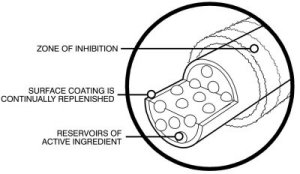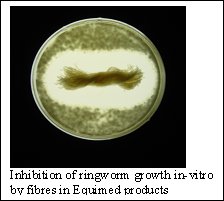|
"University
of Lincoln - Anti-microbial products for companion animals"
The problem
Equines and indeed many other companion animals can suffer from
the disease called Ringworm. Contrary to what the name suggests
this skin disease is caused by a fungus. Ringworm is a highly contagious
skin disease, which means that it can be transmitted though direct
(e.g. animal-animal) and indirect (e.g. rug-animal) contact. Moreover,
it is also known as a zoonotic disease and can, therefore, infect
humans as well.
Though ringworm is not considered a "serious" disease
it does fill most horse owners with dread. It can easily spread
through an entire; it is able to infect staff and owners and it
is likely to prevent the normal every day use of the horse. It can
affect horses of all breeds and ages and can readily be transmitted
to dogs and cats as well as their owners.
The disease
The main fungal species that causes ringworm in horses is Trichophyton
equinum. Infection with Microsporum species is less common but still
highly contagious. The disease is mainly transmitted through contact
with infected horses or contaminated equipment, transferring the
skin cells and spores to the next victim. The presence of skin abrasions,
however subtle, will strongly increase the chance of getting infected
with ringworm. As a result, areas subject to skin friction (e.g.
girth, bridle) are particularly at risk. Biting insects can also
contribute to the spread of ringworm.
The symptoms usually start with patches of raised hairs in a circular
(ring) pattern. The hairs give way easily when plucked and hair
loss follows, leaving a silvery scaling of the underlying skin.
The lesions are only pruritic (itchy) in the early stages of the
disease but can remain sensitive to the touch for longer periods.
The initial ringworm lesions can spread outwards to cover large
areas of the body, if no appropriate measures are taken.
The disease usually resolves spontaneously within 6-12 weeks, but
the fungal spores that have contaminated the stable environment
and equipment may persist for years.
The treatment
Though it may resolve spontaneously, treatment can decrease the
severity of symptoms and limit the spread of infection on the animal
and between animals. It does, however, not necessarily shorten the
healing time. Treatment is usually in the form of medicated (fungicidal)
washes to kill the fungus on the horse. Oral treatment is also available
but with varying results and is unlikely to reduce the spread of
infection.
The prevention
As no treatment actually shortens the healing time of ringworm,
prevention is key in order to avoid an outbreak on a yard. Vaccinations
are becoming more widely available as research into these continues.
However, results are variable and the process of repeated boosters
may not be practical or economical.
Maintaining hygienic work practices is key to preventing a ringworm
outbreak on an equine yard. These practices help to minimise the
chance of environmental contamination. If an outbreak should occur
then control of the outbreak is through prevention of the spread
between horses. Anti-fungal drugs and fungicidal washes will treat
the fungus on the horse, whilst disinfection of the stable environment
and equipment will limit indirect transmission.
The alternative -prevention-
One of the main environmental sources of ringworm is the contaminated
rug. A horse rug by its very nature comes into contact with horse
skin, stable floor, bedding, equipment etc. Irrespective of whether
the horse shows symptoms of ringworm, the rug may have picked up
spores and may remain contaminated indefinitely. Daily washing of
horse rugs would be advisable but totally unpractical.
An alternative would be to prevent the fungus from persisting in
the rug in the first place. By incorporating an antifungal fibre
within the rug material, Equimed is able to limit the contamination
of the rug. The active compound, Tolnaftate, will help prevent the
persistence of the fungus within the rug. The Equimed rug will create
an anti-fungal environment whilst on or off the horse and can help
protect against ringworm.
The products
The "anti-ringworm" fibre can be integrated into any fabric
without affecting the function of the garment. As a result Equimed
has successfully incorporated the fibre in a state of the art range
of horse products. So far these include stable rugs, turnout rugs,
coolers, numnahs and saddlecloths.

The fibre (AmicorTM) consists of the anti-microbial core surrounded
by a semi permeable acrylic sheath. This allows the anti-fungal
action to permeate out and continuously replenish the surface of
the fibres. Due to the built in activity, textiles containing this
fibre do not have to be re-impregnated or treated in any way to
maintain their antifungal activity. The products can be washed as
frequently as desired without losing its "anti-ringworm"
activity. It also includes a mild anti-bacterial activity, which
helps reduce bacterial contamination and odour production.

The proof
Extensive research has been carried out to demonstrate that the
Equimed textile is effective against ringworm. Trials were carried
out with ringworm organisms Trichophyton equinum and Microsporum
canis. The results demonstrated clearly the antifungal inhibition
against these ringworm-causing organisms in-vitro.
Not just for ringworm. Equimed textile has shown effectiveness
against:
- Bacterial
contamination (including MRSA)
- Fungal
contamination
as a result these products can:
- Help protect you and your cat, dog or horse against
ringworm infection
- Help protect your cat or dog against Malassezia
yeast infection
- Help protect your cat, dog or horse against dust
mite allergies
- Help reduce bacterial and fungal odour
production
- Help reduce wound contamination
If
you need more details, require
some Medibed or wish to participate
in reseach, feel free to contact fruedisueli@lincoln.ac.uk
References
More Related Research and Anti-microbial
Products
|

